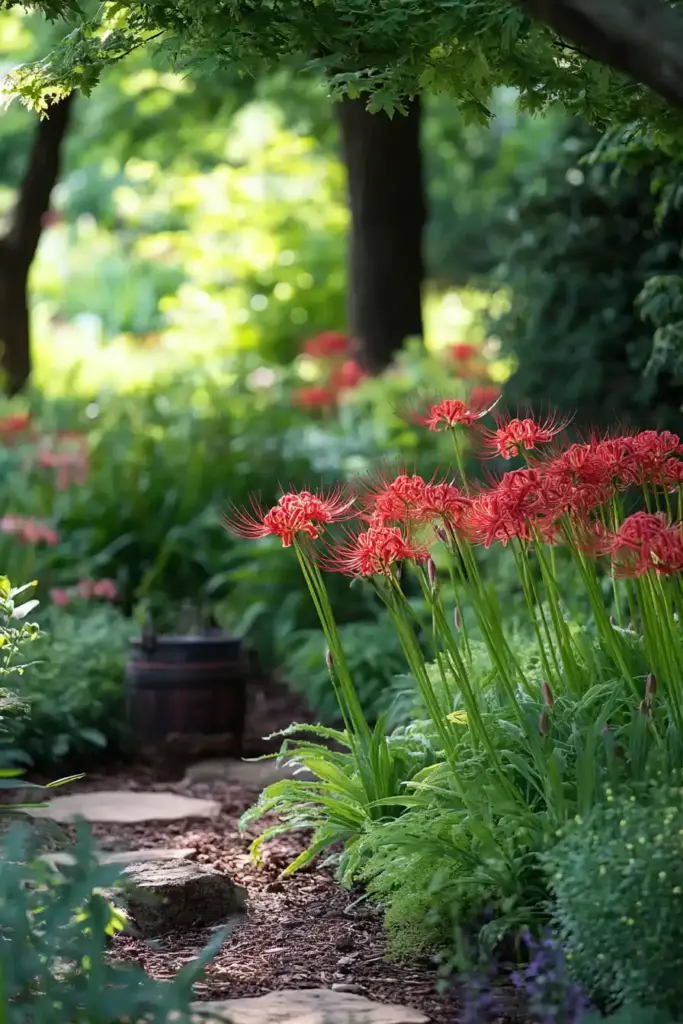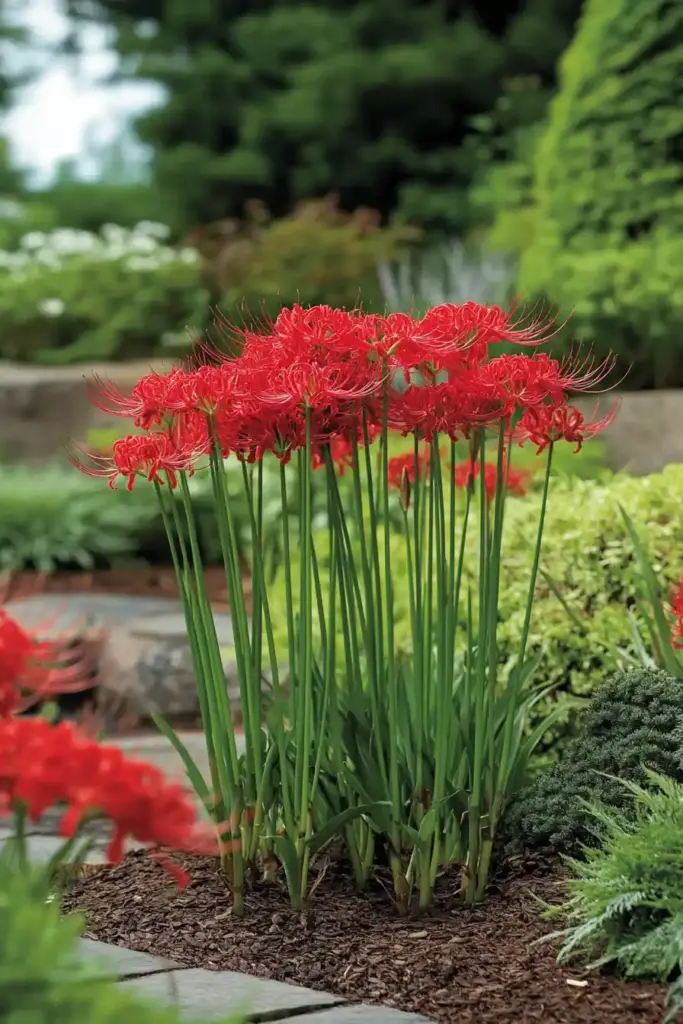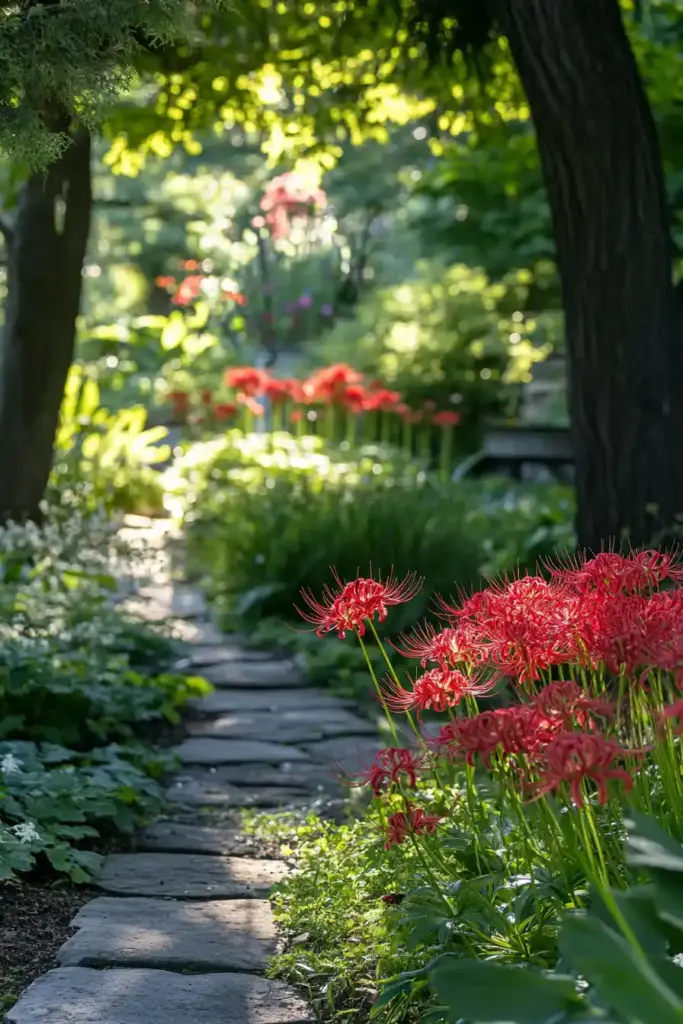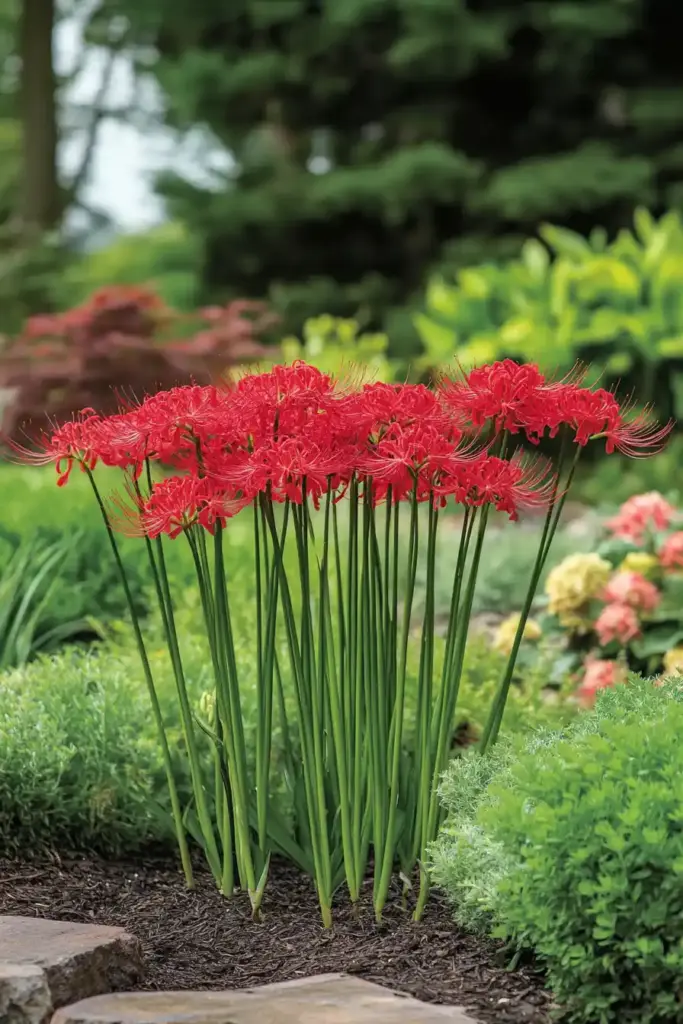If you’re looking to add an enchanting burst of color to your late-summer garden, spider lilies (Lycoris spp.) are a magical choice. These dramatic bloomers—often called hurricane lilies, magic lilies, or surprise lilies—emerge suddenly after summer rains, producing vivid, spidery flowers atop tall, leafless stalks. Their fleeting display, usually lasting around two weeks, feels like a seasonal secret whispered to attentive gardeners.
Spider lilies grow from bulbs and require minimal upkeep, making them ideal for gardeners who want low-maintenance beauty. They’re disease-resistant, deer-resistant, and a pollinator magnet, attracting bees and butterflies with their whimsical blooms. Whether you’re planting in borders, woodlands, or containers, these plants offer stunning rewards with very little fuss.
Table of Contents
Planting Spider Lilies
Getting started with spider lilies is easy and rewarding. These bulbs thrive when planted at just the right time and in the proper conditions.
When to Plant
For best results, plant spider lily bulbs in early fall or early spring. These seasons offer the ideal soil temperature and moisture conditions to help bulbs establish roots before blooming.
Light and Soil Requirements
- Sunlight: Aim for full sun to partial shade. More sunlight typically means more vibrant flowers, though partial shade is ideal in warmer regions.
- Soil: Choose rich, moist but well-draining soil. A slightly alkaline pH is preferred. Make sure the area dries out between watering or rainfall to prevent rot.
How to Plant
- Dig a hole deep enough to allow the bulb’s neck to sit just above the soil surface—this is critical.
- Place the bulb pointed end up.
- Do not bury the top of the bulb, as this may prevent flowering.
- Space bulbs about 12 inches apart to give them room to grow and naturalize over time.
Once planted, you can almost forget about them—spider lilies are truly a “set-it-and-forget-it” type of flower!
Growing & Caring for Spider Lilies

Spider lilies reward patience and minimal effort with dazzling results. Their unique growth cycle means they often surprise even seasoned gardeners with sudden, late-summer blooms.
Watering Needs
- After planting, water bulbs lightly and consistently until you notice green shoots.
- Once foliage emerges, switch to moderate watering, keeping the soil moist but never soggy.
- In midsummer, when the leaves begin to yellow and wither, stop watering entirely. The bulbs prefer a dry rest period before blooming.
Seasonal Bloom Behavior
After a late-summer rain, spider lilies tend to erupt from the ground almost overnight. With no leaves in sight, their tall, bare stems topped with flamboyant blooms feel like something out of a fairytale garden.
General Maintenance
- Remove faded foliage once it turns yellow—it’s done its job.
- Divide bulbs every 7 years to prevent overcrowding and encourage better blooming.
- Avoid frequent digging—spider lily roots are delicate and don’t respond well to disturbance.
This low-maintenance routine makes spider lilies a long-term staple for anyone looking to add effortless elegance to their landscape.
Propagation
Expanding your spider lily collection is simple, but it requires a bit of patience.
How to Propagate
- The best time to divide spider lily bulbs is after they finish blooming.
- Carefully dig up the bulb clumps and gently separate the offsets—smaller bulbs growing alongside the parent.
- Replant immediately in well-prepared soil, keeping the necks of the bulbs just above the soil line.
What to Expect After Transplanting
- Newly transplanted spider lilies often won’t bloom the first year.
- This delay is normal—they dislike having their roots disturbed and need time to settle in.
- With time and minimal interference, they’ll return to their dramatic, magical performance.
By dividing every few years, you not only keep your plants healthy and vigorous but also create new patches of stunning late-season color.
Pests and Problems

One of the many reasons gardeners love spider lilies is their resilience. These bulbs are tough, independent, and rarely troubled by garden nuisances.
Common Issues
- Pest Resistance: Spider lilies are naturally resistant to most pests and diseases, which makes them an ideal choice for low-maintenance landscapes.
- Deer-Resistant: Their bulbs and blooms are not attractive to deer, making them great for gardens in rural or wooded areas.
- Pollinator-Friendly: While pests stay away, bees and butterflies are drawn to the blooms—adding life and motion to your garden.
Potential Problems
- Root Rot: The main threat is excess moisture. Planting in soil that doesn’t drain well can cause root rot, which will quickly damage or kill the bulb.
- Lack of Blooms: If your spider lilies aren’t flowering, too much shade could be the culprit. Make sure they’re getting plenty of sun or dappled light during the growing season.
Overall, with a bit of attention to drainage and light, spider lilies can thrive year after year with little intervention.
Recommended Varieties of Spider Lily

With their exotic shapes and vibrant colors, spider lilies come in several standout varieties. Each offers something special for different garden styles and climates.
Red Spider Lily (Lycoris radiata)
- Color: Bright coral-red flowers with gracefully curled petals and long, upward-sweeping stamens.
- Height: Up to 24 inches tall.
- Traits: This heirloom favorite thrives in Southern gardens, often passed down for generations.
- Best For: Partial shade in warmer zones. In tropical areas, it sends up foliage in fall and may bloom throughout winter.
White Spider Lily (Lycoris albiflora)
- Color: Clusters of six to eight creamy white blooms with subtle pink stripes.
- Traits: The curved stamens add to its delicate charm, making it an excellent cut flower for arrangements.
- Best For: Gardeners looking for soft, elegant tones and fragrant additions to bouquets.
Naked Ladies (Lycoris squamigera)
- Color: Trumpet-shaped flowers in lilac-pink tones.
- Growth Habit: Produces strap-like foliage in spring, which disappears in summer, followed by a surprise fall bloom.
- Height: Blooms rise on 18-inch stalks with no surrounding leaves—hence the nickname.
- Best For: Cooler zones or gardeners who love seasonal surprises and contrast.
These three types cover a wide spectrum of color and form, allowing you to mix and match for dynamic garden displays throughout late summer and early fall.
Garden Uses
Spider lilies are more than just beautiful—they’re incredibly adaptable in both formal and informal garden settings. With their bold blooms and upright habit, they add structure, color, and surprise to your landscape.
Landscape Ideas
- Mass Plantings: For maximum visual impact, plant spider lilies in large drifts within shrub or perennial borders. Their unexpected blooms create a striking contrast against late-season foliage.
- Shaded Pathways: Use them to line a partially shaded walkway, where their sudden appearance brings seasonal interest and charm.
- Naturalized Areas: Let them naturalize in transitional zones—such as between lawns and woodlands—where they’ll multiply slowly over time with little care.
Design Combinations
- With Foliage Plants: Pair spider lilies with textured greenery like hostas or ferns to emphasize their sleek stems and vibrant flowers.
- With Spring Bulbs: Interplant with spring bloomers such as daffodils or tulips. Spider lilies provide fall color in the same space after spring bulbs have faded.
Container Gardening
- Containers in Cooler Zones: If you live outside their hardiness range, grow spider lilies in pots and move them indoors during winter.
- “Thriller” in Arrangements: In mixed container plantings, spider lilies serve as a thriller element, adding vertical drama and floral elegance.
Cut Flower Use
Spider lilies also make excellent additions to cut flower gardens. Their dramatic form and long-lasting blooms bring a sophisticated, exotic feel to floral arrangements.
🌿 Frequently Asked Questions About Growing Spider Lilies

1. When is the best time to plant spider lily bulbs?
The best time to plant spider lily bulbs is in early fall or early spring. This gives the bulbs enough time to establish roots before their late-summer blooming season.
2. Do spider lilies need full sun or shade?
Spider lilies thrive in full sun to partial shade. In hotter climates, they may perform better with a bit of afternoon shade to prevent stress.
3. How long do spider lilies bloom?
The blooms typically last about two weeks, often appearing suddenly after a summer rain. Their fleeting beauty is part of their charm.
4. Can I grow spider lilies in containers?
Yes! Spider lilies grow well in containers, especially in areas outside their hardiness zones. Use well-draining soil and ensure they get plenty of light.
5. Why aren’t my spider lilies blooming?
Lack of blooms is usually due to too much shade, poor drainage, or bulbs being planted too deep. Ensure the neck of the bulb is just above the soil surface.
6. Are spider lilies toxic to pets?
Yes, like many bulb plants, Lycoris species are toxic to pets if ingested. Keep them out of reach of curious animals.
7. Do spider lilies come back every year?
Absolutely. Spider lilies are hardy perennials that return each year and can even multiply when left undisturbed.
8. How do I divide spider lily bulbs?
Dig and divide bulbs after flowering, every 5–7 years. Gently separate the offsets and replant them with the neck just above the soil.
Conclusion
Spider lilies are the garden’s best-kept secret—popping up unexpectedly with bold, spidery blooms just when most other flowers are fading. With minimal care and high visual impact, they’re a must-have for anyone looking to add seasonal drama, pollinator appeal, and old-world charm to their landscape.
Whether you’re planting in borders, containers, or naturalized settings, these low-maintenance bulbs bring bursts of beauty and joy each year. Just plant them right, give them space, and let nature handle the rest.


